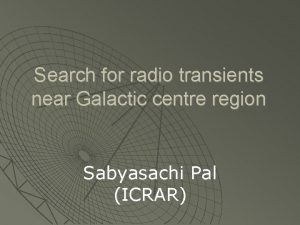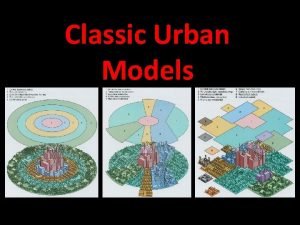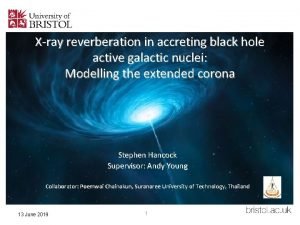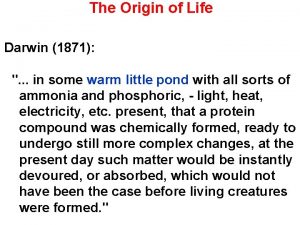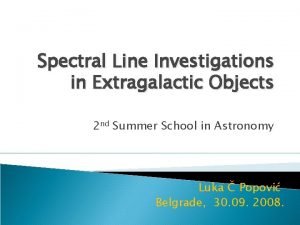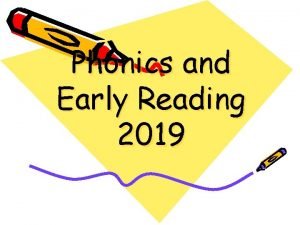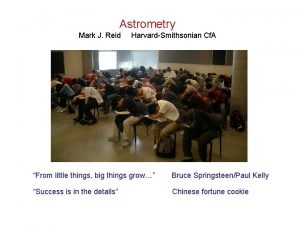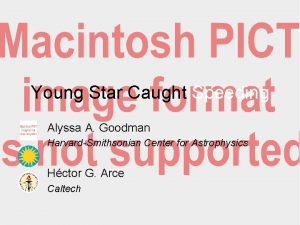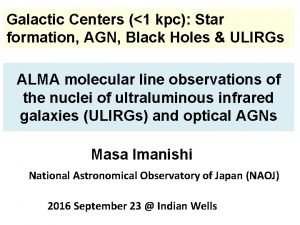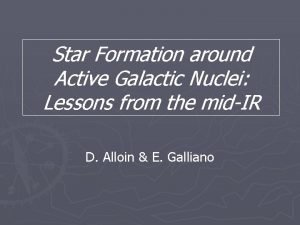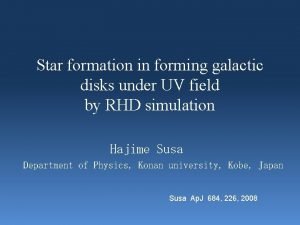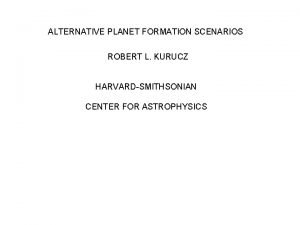Star Formation The Galactic Center Mark Reid HarvardSmithsonian











- Slides: 11

Star Formation & The Galactic Center Mark Reid Harvard-Smithsonian Cf. A January 10, 2006 AAS EVLA Town Hall Meeting 1

Massive Star Formation • Solar-mass star formation paradigm: accretion disk Still not critically tested 500 AU • Massive star formation: HST: Orion Nebula “Proplyd” No paradigm yet Coalescence possible January 10, 2006 AAS EVLA Town Hall Meeting 2

IR & Radio • Orion-I (IRc 2): Dominant massive star in KL region • Obscuration problem: Av ~ 100’s to 1000’s AIR ~ 10’s to 100’s Need radio waves to see inside Menten & Reid (1995) January 10, 2006 AAS EVLA Town Hall Meeting 3

Orion-I • VLA continuum image 0. 1 arcsec = 50 AU 43 GHz (7 mm) 40 mas = 20 AU resolution • VLBA line image Si. O masers 0. 5 mas =0. 25 AU resolution Greenhill, Reid, Menten & Chandler January 10, 2006 AAS EVLA Town Hall Meeting 4

Disk Geometry 0. 1 arcsec = 50 AU Massive star protostellar “disk”: resolved by VLA Seeing material expelled from disk (rotating outflow) January 10, 2006 AAS EVLA Town Hall Meeting 5

EVLA Contributions • EVLA-I: increased sensitivity (x 10) Current image barely detected; increased sensitivity will allow studying details (eg, disk thickness, disk truncation, jet formation, etc. ) Move from studying nearest source to many others, eg, in Cep A, NGC 6334, W 3, etc. • EVLA-II: increased angular resolution (x 10) Resolve internal structures: eg, gaps, density distribution January 10, 2006 AAS EVLA Town Hall Meeting 6

Galactic Center Radio Infrared Sgr A* 10 arcsec ~ 1 l. y. VLA: 1 cm January 10, 2006 (Zhao) VLT / NACO 1. 6 -3. 5 microns AAS EVLA Town Hall Meeting 7

Radio/IR Astrometry 10 arcsec ~ 1 ly Grid of stars visible in IR and Radio Red Giant stars with Si. O masers: Radio frame “perfect” Reid & Menten (2003) January 10, 2006 AAS EVLA Town Hall Meeting 8

Where is Sgr A*? 1995 2002 1 arcsec = 0. 04 pc S 2 Sgr A* position 2. 2 -m l Menten, Reid, Eckart & Genzel (1997) January 10, 2006 AAS EVLA Town Hall Meeting Reid et al (2003) 9

Stellar Orbits • Limited by distortions across IR frame Requires grid of reference stars to remove systematic errors Need < 1 mas accuracy • Deviation from elliptical orbits give Extended dark matter Stellar remnant graveyard Effects of BH spin (precession) • G. C. distance: Ro (<1% unc. ) Galaxy rotation speed (<1% unc. ) Recalibrate EG distance scale Credit: Ghez & Tanner January 10, 2006 AAS EVLA Town Hall Meeting 10

EVLA Contributions • EVLA-I: Super correlator (x 12 speed-up) Observe all stars (+/- 400 km/s) simultaneously; currently requires >12 bands observed sequentially Increased sensitivity => more stars, <1 mas positions • EVLA-II: increased angular resolution (x 10) Increase astrometric accuracy from <1 mas to <0. 1 mas January 10, 2006 AAS EVLA Town Hall Meeting 11

